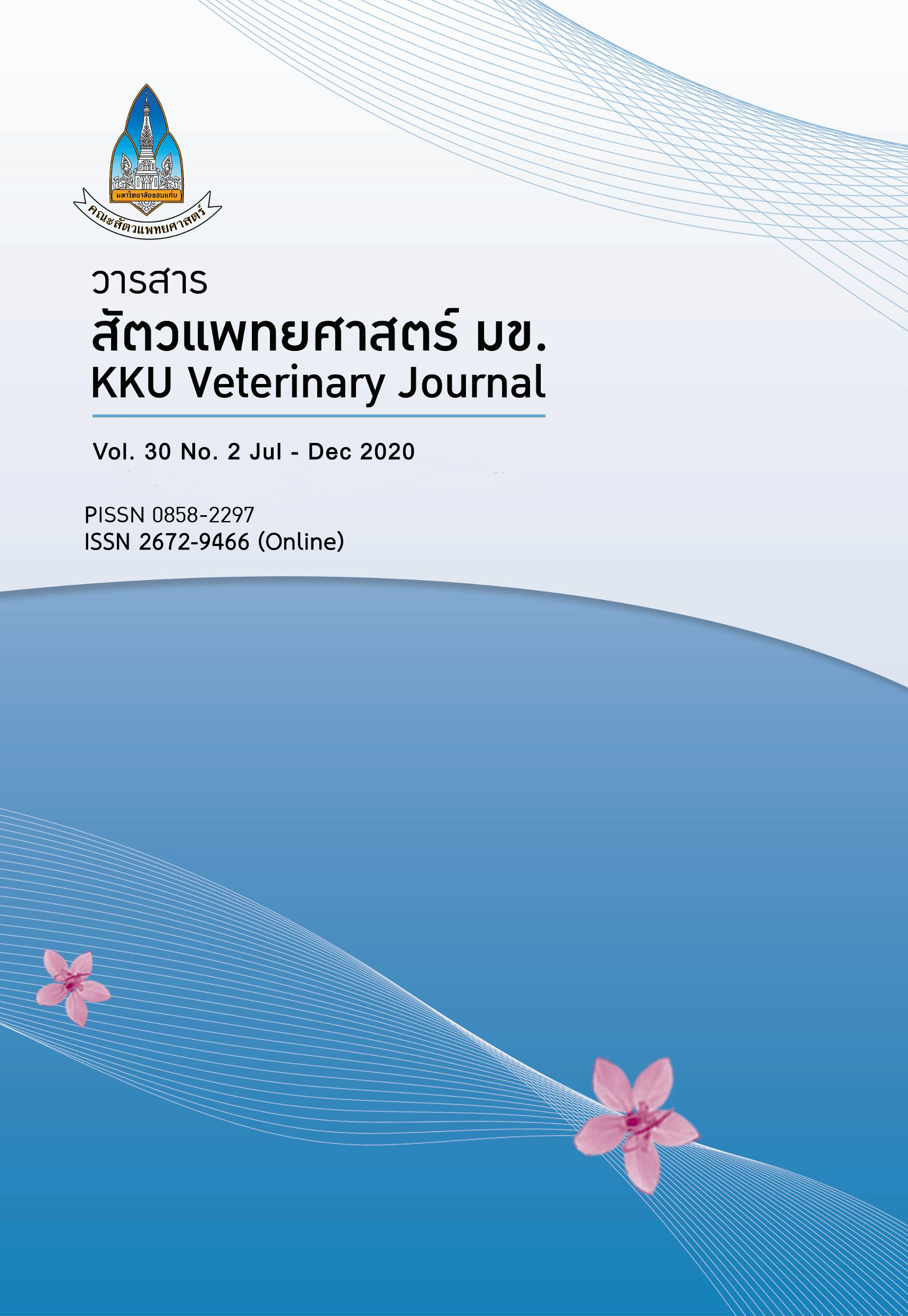ผลของการจัดท่าของร่างกายต่อตัวแปรทางคลื่นไฟฟ้าหัวใจในสุนัขพันธุ์ลาบราดอร์รีทีฟเวอร์
Main Article Content
บทคัดย่อ
วัตถุประสงค์: การศึกษานี้มีวัตถุประสงค์เพื่อศึกษาอิทธิพลของการจัดท่าของร่างกายต่อค่าตัวแปรทางคลื่นไฟฟ้าหัวใจในสุนัขพันธุ์ลาบราดอร์รีทีฟเวอร์
วัสดุ อุปกรณ์ และวิธีการ: การบันทึกคลื่นไฟฟ้าหัวใจกระทำในสุนัขพันธุ์ลาบราดอร์รีทีฟเวอร์จำนวนทั้งหมด 10 ตัว ใน 3 ท่า คือ ท่านอนตะแคงขวา (ท่ามาตราฐาน) ท่ายืน และท่านอนตะแคงซ้าย โดยการบันทึกใช้ลีดแบบมาตราฐานสองขั้วที่ระยางค์ ได้แก่ ลีด I, II, และ III และลีดแบบขั้วเดียว ได้แก่ ลีด aVR, aVL, และ aVF ทำการวัดค่าแอมพลิจูดและช่วงเวลาของคลื่นพี คิวอาร์เอสและที ร่วมกับการหาค่าช่วงเวลาของพีอาร์และคิวที ค่าแกนของหัวใจ และอัตราการเต้นของหัวใจในทุกการบันทึก
ผลการศึกษา: พบว่าไม่มีความแตกต่างอย่างมีนัยสำคัญทางสถิติในค่าแอมพลิจูดของคลื่นพี (P=0.88) ช่วงเวลาของคลื่นพี (P=0.69) ช่วงเวลาของพีอาร์ (P=0.85) ช่วงเวลาของคิวอาร์เอส (P=0.18) ค่าแอมพลิจูดของคลื่นอาร์ (P=0.24) และอัตราการเต้นของหัวใจ (P=0.42) ระหว่าง 3 ท่า ค่าช่วงเวลาและแอมพลิจูดของคลื่นทีและช่วงเวลาคิวทีมีค่าลดลงอย่างมีนัยสำคัญทางสถิติในท่ายืนเมื่อเปรียบเทียบกับท่านอนตะแคงขวา (P=0.03, 0.01, and 0.02, ตามลำดับ) ค่าแกนของหัวใจไม่มีความแตกต่างทางสถิติในท่านอนตะแคงซ้ายเมื่อเปรียบเทียบกับท่านอนตะแคงขวา แต่อย่างไรก็ตามค่าแกนของหัวใจมีค่าลดลงอย่างมีนัยสำคัญทางสถิติในท่ายืนเมื่อเปรียบเทียบกับท่านอนตะแคงขวา (P<.0001)
สรุป: การศึกษานี้บ่งชี้ว่าค่าแกนของหัวใจเคลื่อนย้ายไปทางซ้ายและมีสิ่งแปลกปนจากการสั่นของกล้ามเนื้อมากขึ้นในท่ายืน มีความจำเป็นในการประเมินการบันทึกคลื่นไฟฟ้าจากประชากรสุนัขจำนวนมากเพื่อหาค่าอ้างอิงมาตราฐานในท่าอื่น อย่างไรก็ตามเมื่อผู้บันทึกคลื่นไฟฟ้าหัวใจต้องการการวัดค่าและการแปลผลค่าแอมพลิจูดและค่าแกนของหัวใจที่ถูกต้อง ขณะบันทึกควรจัดให้สุนัขอยู่ในท่านอนตะแคงขวา
Article Details
เอกสารอ้างอิง
Coleman MG, Robson MC. 2005. Evaluation of six-lead electrocardiograms obtained from dogs in a sitting position or sternal recumbency. Am J Vet Res 66, 233-237.
Detweiler. 1993. The dog electrocardiogram: A critical review. In: Macfarlane PW, Veitch Lawrie TD, ed. Comprehensive electrocardiology. Theory and practice in health and disease. New York, NY: Pergamon Press 1267–1329.
Dvir E, Cilliers PJ, Lobetti RG. 2002. Effect of electrocardiographic filters on the R-amplitude of canine electrocardiograms. Vet Rec 150, 171-176.
Fraley MA, Birchem JA, Senkottaiyan N, Alpert MA. 2005. Obesity and the electrocardiogram. Obes Rev 6, 275-281.
Gugjoo MB, Hoque M, Saxena AC, Zama MM. 2014. Reference values of six-limb-lead electrocardiogram in conscious Labrador retriever dogs. Pak J Biol Sci 17, 689-695.
Hanton G, Rabemampianina Y. 2006. The electrocardiogram of the Beagle dog: reference values and effect of sex, genetic strain, body position and heart rate. Lab Anim 40, 123-136.
Harvey AM, Faena M, Darke PG, Ferasin L. 2005. Effect of body position on feline electrocardiographic recordings. J Vet Intern Med 19, 533-536.
Mankowska M, Krzeminska P, Graczyk M, Switonski M. 2017. Confirmation that a deletion in the POMC gene is associated with body weight of Labrador Retriever dogs. Res Vet Sci 112, 116-118.
Martin M. 2007. Small Animal ECGs: An introductory guide.Second Edition, Blackwell Publishing editorial offices: Blackwell Publishing Ltd, 9600 Garsington Road, Oxford OX4 2DQ, UK.
Mukherjee J, Das PK, Ghosh PR, Banerjee, D, Sharma, T, Basak, D, Sanyal, S. 2015. Electrocardiogram pattern of some exotic breeds of trained dogs: A variation study. Vet World 8, 1317-1320.
Nahas K, Geffray B. 2004. QT interval measurement in the dog: chest leads versus limb leads. J Pharmacol Toxicol Methods 50, 201-207.
Rishniw M, Porciello F, Erb HN, Fruganti G. 2002. Effect of body position on the 6-lead ECG of dogs. J Vet Intern Med 16, 69-73.
Schrope DP, Fox PR, Hahn AW, Bond B, Rosenthal S. 1995. Effects of electrocardiograph frequency filters on P-QRS-T amplitudes of the feline electrocardiogram. Am J Vet Res 56, 1534-1540.
Söder J, Wernersson S, Dicksved J, Hagman R, Östman JR, Moazzami AA, Höglund K. 2019. Indication of metabolic inflexibility to food intake in spontaneously overweight Labrador Retriever dogs. BMC Vet Res 15, 96.
Stern JA, Hinchcliff KW, Constable PD. 2013. Effect of body position on electrocardiographic recordings in dogs. Aust Vet J 91, 281-286.
Tilley LP. 1995. Essentials of canine and feline electrocardiography : interpretation and treatment, Cann,C.C.(Ed.). Vol.3. Lea & Febiger, Philadelphia.
Tilley LP. 2009. Electrocardiography for the Small Animal Practitioner.Teton NewMedia, 90 East Simpson, Suite 110 Jackson, WY 83001.
Willis R. 2018. Guide to Canine and Feline Electrocardiography. John Wiley & Sons, Inc., 111 River Street, Hoboken, NJ 07030, USA.


